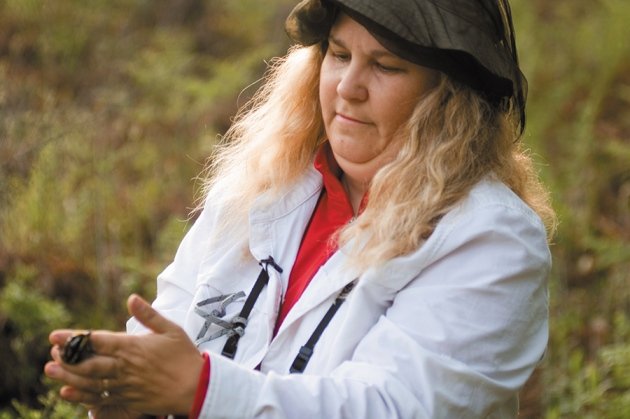
What is sex?
This is a simple question with a complicated answer. Part of the answer is this: The biological identity of an individual that guides its choice of mate. So, in a simple version of the world of a bird, there are two sexes, male and female, and males chose females and females chose males as mates.
Assume for a moment that there is choice, and that the choice is based on a discernible feature. So, for example, males and females prefer to mate with a member of the opposite sex who has a blue and white pattern on its breast. So far so good, and so far simple. A bluer blue together with a whiter white on a female or male will be extra attractive to the member of the opposite sex.
But what if there emerged a genetically novel version of the males who lacked the white, but would only mate with females that lacked the blue. And, the obverse occurred as well. Suddenly you would have multiple sexes, beyond the usual two. There would be two kinds of males and two kinds of females.
Let’s ask the question again, what is sex? In a world in which the final adult outcome with respect to sex can be highly variable, one might look more deeply to find a simple binary observation to tell you if an individual is a male or a female. At the deepest level are presumably some genes, or maybe one gene, that matters, but there may be other equally important things that are not directly genetic as well. For example, in rats (as in “lab rat”) if the mother of a nominally (genetically) male offspring does not repeatedly lick the anogenital region of the pup, the usual cascade of hormones and hormone induced changes, involving androgens, will not occur in that individual and the final outcome will not be a rat that will mount and mate with a female.
Somewhere in between the gene and the anogenetical licking (or gender policing or incubation temperature or whatever else matters) is the sex chromosome. A sex chromosome may be a section of DNA (as a chromosome is) that has multiple genes on it, some of which are related to sex determination. In many cases, all. In some cases, very few.
I have a theory about sex chromosomes. They form and have lots of genes on them, but over time, all the non sex-related genes abandon the chromosome. Why? That’s beyond the scope of this mere blog post.
So, now, we have established something about sex. Two things, really. What it is at the surface, and something about how it gets that way. And this brings us to Zonotrichia albicollis, the White-Throated Sparrow.
From a recent article in Nature,
“This bird acts like it has four sexes,” says Christopher Balakrishnan, an evolutionary biologist at East Carolina University in Greenville, North Carolina, who worked with Tuttle and Gonser. “One individual can only mate with one-quarter of the population. There are very few sexual systems with more than two sexes.”
A subset of Adirondack White-Throated Sparrows have undergone a mutation that flipped a large piece of Chromosome 2, whihc messes up the usual genetic processes in that area. This section of chromosome is now effectively a super-gene that doesn’t do anything other than make a lot of other genes not do something, or otherwise act differently. The result is that sparrows with this gene have different mating preferences than other sparrows.
It is hypothesized that this is the formation of a new sex chromosomes, right before the eyes of scientists. This system shows …
…how two identical chromosomes can evolve into distinct subtypes that can define the sexes of a species and their different behaviours. “These birds are an amazing system,” says Catherine Peichel, an evolutionary ecologist at the University of Berne. “The process of sex-chromosome evolution tends to erase much of the evidence of how it happened, so being able to watch the process in action is a huge benefit.”
Rusty Gonser and Elaina Tuttle, who recently died too early of cancer, have collected more than three decades of data on these birds, at their Cranberry Lake research station.
The story of this research, how they started out, how they figured out what was going on, is a long and fascinating one. To fully reproduce it here would be to disrespect the excellent work of Carrie Arnold, who has an excellent writeup in Nature which, if I am not mistaken, is not behind a firewall: The sparrow with four sexes: Elaina Tuttle spent her life trying to understand the bizarre chromosome evolution of a common bird — until tragedy struck. This is partly an homage to the recently deceased Elaina Tuttle and her remarkable career. Go read it!













Isn´t this just the first step in the creation of a new species?
In Norway, we have two kinds of cod, and I know that it has now been found that the difference between them is reversal of a chromosomal string that contains more than 700 genes. Unfortunately I have not found anything about it in English, but this link explais it in Norwegian:
https://nofima.no/nyhet/2016/03/torskegaten-er-lost/
Greg
I found an English article about the subject that I mentioned. You can find the abstract here:
http://onlinelibrary.wiley.com/doi/10.1111/mec.13592/abstract
I have the full text if you do not have access to it. Just tell me. I have also heard that something similar was lately published about ruff males, saying that there are three types of males. But you probably know about that?
Jarle: Thanks, that’s interesting!
Here, we have two absolutely identical species of frog that are considered different because one is diploid and the other polyploid. IN some ways that is less extreme, but stranger at the same time.
(That’s the North American Tree Frog and the Other North American Tree Frog)